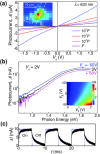High broad-band photoresponsivity of mechanically formed InSe-graphene van der Waals heterostructures
- PMID: 25981798
- PMCID: PMC4768130
- DOI: 10.1002/adma.201500889
High broad-band photoresponsivity of mechanically formed InSe-graphene van der Waals heterostructures
Abstract
High broad-band photoresponsivity of mechanically formed InSe-graphene van der Waals heterostructures is achieved by exploiting the broad-band transparency of graphene, the direct bandgap of InSe, and the favorable band line up of InSe with graphene. The photoresponsivity exceeds that for other van der Waals heterostructures and the spectral response extends from the near-infrared to the visible spectrum.
Keywords: graphene; indium selenide; photoconductivity; van der Waals crystals.
© 2015 The Authors. Published by WILEY-VCH Verlag GmbH & Co. KGaA, Weinheim.
Figures





References
-
- Geim A. K., Grigorieva I. V, Nature 2013, 499, 419. - PubMed
-
- Novoselov K. S., Rev. Mod. Phys. 2011, 83, 837.
-
- Britnell L., Ribeiro R. M., Eckmann A., Jalil R., Belle B. D., Mishchenko A., Kim Y. J., Gorbachev R. V., Georgiou T., Morozov S. V., Grigorenko A. N., Geim A. K., Casiraghi C., Castro Neto A. H., Novoselov K. S., Science 2013, 340, 1311. - PubMed
-
- Georgiou T., Jalil R., Belle B. D., Britnell L., Gorbachev R. V, Morozov S. V, Kim Y.‐J., Gholinia A., Haigh S. J., Makarovsky O., Eaves L., a Ponomarenko L., Geim A. K., Novoselov K. S., Mishchenko A., Nat. Nanotechnol. 2013, 8, 100. - PubMed
-
- Mishchenko A., Tu J. S., Cao Y., Gorbachev R. V., Wallbank J. R., Greenaway M. T., Morozov V. E., Morozov S. V., Zhu M. J., Wong S. L., Withers F., Woods C. R., Kim Y‐J., Watanabe K., Taniguchi T., Vdovin E. E., Makarovsky O., Fromhold T. M., Falko V. I., Geim A. K., Eaves L., Novoselov K. S., Nat. Nanotechnol. 2014, 9, 808. - PubMed
LinkOut - more resources
Full Text Sources
Other Literature Sources

